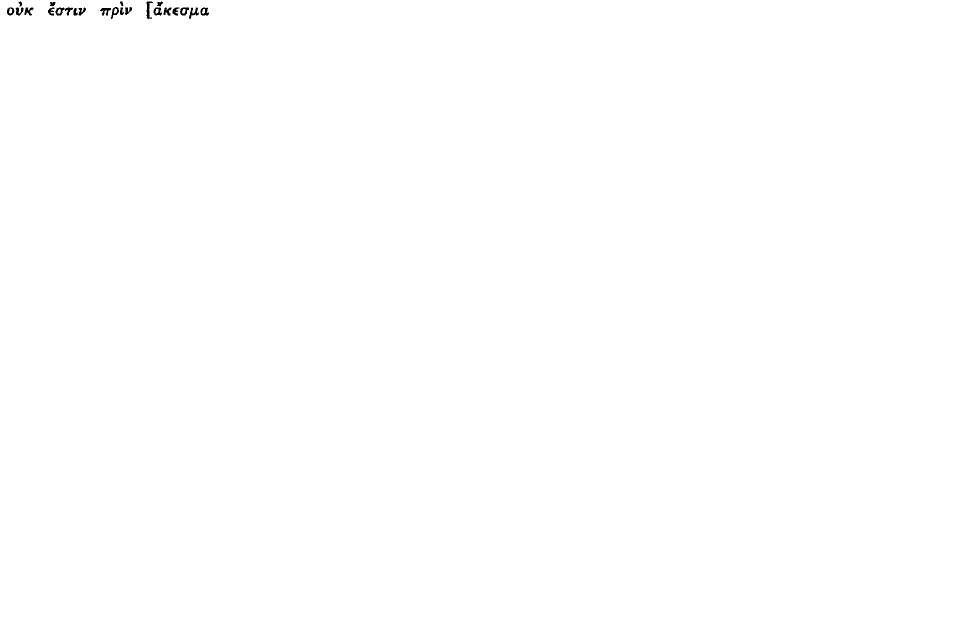Article contents
The Newly Discovered Delphic Responses from Paros
Published online by Cambridge University Press: 11 February 2009
Extract
In the  for 1952 (Athens, 1955), pp. 33 ff., Nikolaos M. Kontoleon published a most interesting inscription from the shrine of Archilochos on Paros. It was inscribed, as preserved, on two orthostats, which probably formed part of the structure of the hearth or bothros where offerings to the hero were made. There is much of interest to scholars in this new discovery, which is very fully and carefully interpreted by Kontoleon, and has been further discussed by Werner Peck (Philologus, xcix [1955], 4 ff.). In this article the present writer wishes to confine himself to some comments on the new evidence about responses of the Delphic oracle supplied by the inscription. This material is all found on the first of the two orthostats, and falls into two categories: responses connected with the setting up of the shrine, and responses connected with the life of Archilochus.
for 1952 (Athens, 1955), pp. 33 ff., Nikolaos M. Kontoleon published a most interesting inscription from the shrine of Archilochos on Paros. It was inscribed, as preserved, on two orthostats, which probably formed part of the structure of the hearth or bothros where offerings to the hero were made. There is much of interest to scholars in this new discovery, which is very fully and carefully interpreted by Kontoleon, and has been further discussed by Werner Peck (Philologus, xcix [1955], 4 ff.). In this article the present writer wishes to confine himself to some comments on the new evidence about responses of the Delphic oracle supplied by the inscription. This material is all found on the first of the two orthostats, and falls into two categories: responses connected with the setting up of the shrine, and responses connected with the life of Archilochus.
- Type
- Research Article
- Information
- Copyright
- Copyright © The Classical Association 1958
References
1 References by number are to responses in Parke, and Wormell, , The Delphic Oracle (Blackwell, Oxford, 1956), vol. ii.Google Scholar
1 Peck, I.c., p. 13, note 2, well compares the use of the same verb by Xenophon (An. 3. 1.6) in his inquiry at Delphi about the journey which he intended (No. 172).
1 La mantique apollinienne à Delphes (1950), pp. 183 ff.Google Scholar
3 Kontoleon has well illustrated the Delphic and other connexions of the particular deities. Several of them recur in the similar responses quoted above.
1 Caskey, and Beazley, , Attic Vase paintings in the Museum of Boston, No. 37 and pl. 15, where it is interpreted less satisfactorily as the calling of Hesiod by the Muses. Peck, I.c., pp. 23 ff., argues somewhat unconvincingly against Kontoleon's theory.Google Scholar
2 On Oenomaus of Gadara and the Greek Anthology as sources of oracles, see Parke, and Wormell, , The Delphic Oracle, vol. ii, pp. xi and xvii.Google Scholar
1 Cf. Parke, and Wormell, , op. cit. i. 34 and note 80.Google Scholar
2 See Parke, and Wormell, , op. cit. i. 431 under ‘first met’. The earliest example is probably in the oracle about the elder Miltiades and the Dolonci (No. 61).Google Scholar
3 For responses beginning with  , cf. Nos. 133, 406, and 517. For the general pattern, cf. also Nos. 181, 338, and 493.
, cf. Nos. 133, 406, and 517. For the general pattern, cf. also Nos. 181, 338, and 493.
4 The only part of this reconstruction which can be regarded as certain is the supplement  The rest is based on the oracles cited in the previous note. For
The rest is based on the oracles cited in the previous note. For  cf. No. 129. 1, though in a slightly different sense. For
cf. No. 129. 1, though in a slightly different sense. For  , cf. No. 95. 1, and for
, cf. No. 95. 1, and for  cf. No. 4. I owe this exempli gratia reconstruction to my colleague, Professor D. E. W. Wormell. In line 3 Peck suggests
cf. No. 4. I owe this exempli gratia reconstruction to my colleague, Professor D. E. W. Wormell. In line 3 Peck suggests 
 but a reference to the wrath of Dionysus seems necessary, and, if so, this is where it must come.
but a reference to the wrath of Dionysus seems necessary, and, if so, this is where it must come.
1 For Archilochus and Delphi, cf. Park, and Worcnell, , op. cit. i. 155 and 396 ff.Google Scholar
2 Cf. also No. 232, telling Archilochus ti settle in Paros, which probably came fron the same collection.
3 If so, we may perhaps compare to somi extent the foundation oracles of Magnesii on the Maeander (Nos. 378–82). These seen to have been inscribed in connexion with the inquiry at Delphi which led to the declaration of Asylia (221–220 B.C.). They may have been concocted at that date, but may also have been received at that time from Delphi where they had been fabricated rather earlier.
- 2
- Cited by


